Basic Civil & Mechanical Engineering: UNIT III: e. Masonry
Brick Masonry
Terminology, Bonds in Brickwork and its Types, Principles
Brick Masonry is defined as the systematic arrangement of bricks and bonding them together with Cement Mortar or Lime Mortar.
UNIT - III
Chapter - 6 (A)
MASONRY
BRICK MASONRY
Brick
Masonry is defined as the systematic arrangement of bricks and bonding them
together with Cement Mortar or Lime Mortar. The strength of brick masonry depends
upon (i) Quality of the bricks, (ii) Quality of mortar and (iii) Method of
bonding used.
1. TERMINOLOGY
1.
Header: See Fig. 1. A brick laid with its Width W parallel
to the face or direction of a wall is known as Header.
[Or,
a brick laid with its Length L perpendicular to the face of the wall is known
as Header.]

2.
Stretcher: It is a brick laid with its length parallel to face
of the wall.
3.
Course: Course is a horizontal layer of masonry.
4.
Header Course: It is a course or layer of brickwork
showing only headers on the exposed face of the wall.
5.
Stretcher Course: It is a course or layer of brickwork
showing the stretchers on the exposed face of the wall.
6.
Bed:
Bed is the lower surface of a brick in each course.
7.
Bed Joint: Bed Joint is the horizontal layer of
mortar on which bricks are laid.
8.
Lap: Lap is the horizontal distance between the vertical
joints of successive courses.
9.
Quoin: It is a corner of the exterior of the brickwork.
10. Perpends: The vertical joints either in the length or in the cross directions
are known as Perpends.
11.
Arrises: Arrises are the edges formed by the intersection of
plane surfaces of a brick.
12.
Frog: See Fig. 2. Frog is a depression on the top face of
a brick. It is made for forming a key for the mortar.
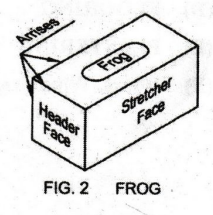
13.
Brick Bat: Brick bat is a piece of brick designated according
to its length. If it is half the length of the brick, it is called a Half Bat
as shown in Fig. 3.
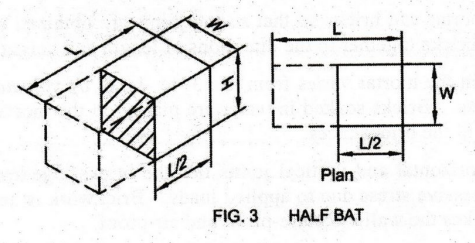
A
Three-quarter ( 3/4 ) Bat is one whose
length is 94 of a brick as shown in Fig. 4.

14.
Closer: It is a piece of brick used
to
close up the bond at the end of brick course. It prevents vertical joints of
successive courses coming one over other. Types of closer are:
(i)
King Closer: See Fig. 5. It is obtained by cutting
triangular portion of the brick such that half a header and half a stretcher
are obtained on the adjoining cut faces.
It
is used near door and window openings to get satisfactory arrangement of mortar
joints.

(ii)
Queen Closer: See Fig. 6. It is a piece of brick
obtained by cutting a brick longitudinally into 2 equal parts. It is placed next to the Quoin Header in
header course.

(iii)
Bevelled Closer: See Fig. 7. Bevelled Closer is obtained
by cutting a triangular portion of the brick, joining half the header and full
stretcher. It is used for splayed brick work like jambs of doors and windows.
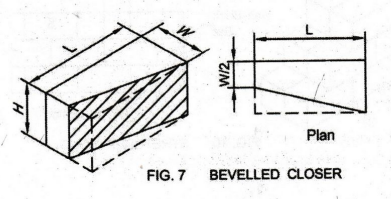
15.
Squint Quoin: See Fig. 8. It is a brick cut such that
an angle other than 90° is formed in plan.
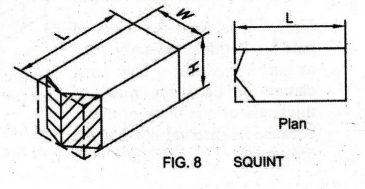
2. BONDS IN BRICKWORK
Bonding
in brickwork is the art of laying mortar and bricks so that strong joints are
obtained in the brick masonry. Proper bonding ties the bricks together in the
directions of length and height.
The
proportion of cement and sand in the mortar varies from 1:3 to 1:6 by volume. A
bed of mortar is spread to 10 mm thickness. Bricks soaked in water are placed
on the mortar and pressed so that the mortar fills the pores in the bricks
faces. Functions of Mortar: (i) Mortar in horizontal and vertical
joints ties the bricks together. (ii) It creates even distribution of the
compressive stress due to applied loads. Brickwork is not subjected to tensile
stresses. (iii) It also makes the wall moisture-proof and air-proof.
3. TYPES OF BONDS IN BRICK MASONRY
1.
Header Bond, 2. Stretcher Bond, 3. English Bond, 4. Flemish Bond and 5. Raking
Bond
1.
HEADER BOND [Figs. 9(i) and (ii)]
In
Header Bond, all the courses have facing of headers. Headers alone are visible in
elevation. Bricks are laid with their Lengths L per-pendicular to the face of
the wall.
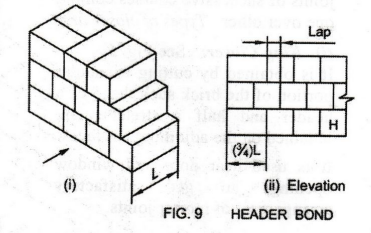
Overlap
of the joint is equal to W/2. This lap is provided by having three-fourth Brick
Bat [ = (3/4) L ] at Quoins of alternate courses.
Uses:
Header bond is used for walls of 1 brick thick, footings and curved wall.
Stretcher bond cannot be used for curved wall, because it may project beyond
the face of the wall.
2.
STRETCHER BOND [Figs 10(i) and (ii)]
Stretcher
Bond consists only of stretchers in all the courses of the face of the wall.
In
this bond, bricks are laid with their Lengths L parallel to the face of the
wall. This bond is also known as Running Bond.
Overlap
of the joint is equal to L/2. This lap is provided by having Half-brick Bat (=
(1/2)L] at Quoins of alternate courses.

Uses:
It is used for walls of half-brick thickness only such as partition walls. This
bond cannot be used for walls of thickness of one brick or more, because its
internal bond is not proper.
3.
ENGLISH BOND
It
consists of alternate courses of headers and stretchers. Vertical joints of the
header courses come over each other. Similarly, the vertical joints of the
stretcher courses also come over each other.
English
Bond for One Brick Thick Wall
See
Figs. 11(i), (ii), (iii), and (iv).

Number
of half bricks for one brick thick wall is equal to 2 (Even Number). If the
wall thickness is an even number of half-bricks, the same course will show
either headers or stretchers on both face and back. That is, the appearance on
both face and back are the same.
Features
of English Bond
•
Alternate Courses: It consists of headers and stretchers
in alternate courses in elevation.
•
Queen Closer: See Figs. 11(i) and (ii). A header
course should never start with Queen Closer, as it will get displaced. A Queen
Closer is placed next to the Quoin Header, in each header course to the full
thickness of the wall. This is done to break the continuity of the vertical
joints in the successive courses. Thus, Lap Joint is provided to create the bond.
Queen Closers are not required in stretcher courses.
•
Alternate Header: Each alternate header lies centrally
over a stretcher.
•
Wall Thickness in Even Number of Half-bricks: See Fig. 11. If
the wall thickness is an even number of half-bricks, the same course will show
either headers or stretchers on both face and back. That is, the appearance on
both face and back are the same.
•
Continuous Vertical Joints: These should not be allowed except at the
stopped end.
•
Wall Thickness of Two Bricks or More: Interior or Hearting of these
thicker walls should be filled with headers only.
•
Thinner Header Course: There are
more vertical joints in the header course than in stretcher course. Hence, the
joints in the header course should be thinner than in the stretcher course.
English
Bond for One and a Half Brick Thick Wall: See Figs.
12(i), (ii) and (iii).

In
English Bond, if the wall thickness is an odd number of half-bricks, the same
course will show headers on the face and stretchers on the back or stretchers
on the face and headers on the back of the wall.
Elevation
is as shown in Fig. 11(ii).
Uses:
English bond is the most commonly used bond for all wall thicknesses. strongest
type of bond.
4.
FLEMISH BOND
Features
of Flemish Bond
•
In Flemish Bond, headers and stretchers are laid alternately in each course.
•
Every alternate course starts with a header at the corner i.e., Quoin Header.
•
Queen Closer is laid next to the Quoin Header in alternate course to develop
the face lap for creating the bond.
•
Every header is centrally supported over the stretcher below it.
•
If the wall thickness is an odd number
of half bricks, more brick Bats are to be used.
•
This type of bond gives a better
appearance, because the headers are distributed evenly
Types
of Flemish Bond
1.
Double Flemish Bond
In
this, each course presents the same appearance both in front and back faces.
Hence, it gives better appearance than English Bond. But, it is not as strong
as the English Bond.
Salient
Features of Double Flemish Bond
•
Every course consists of headers and stretchers placed alternately.
•
Queen Closers are placed next to quoin header in every alternate course.
•
The face and back of the wall in each course have same appearance.
Double
Flemish Bond for One Brick Thick Wall: [Figs. 13(i), (ii),
(iii) and (iv)]
If
the thickness of the wall is an even number of half-bricks, no bats are
required.
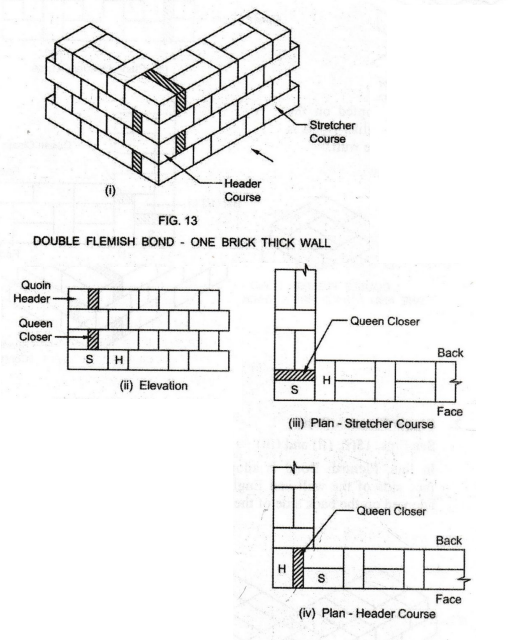
Double
Flemish Bond for One and a Half Brick Thick Wall
[Figs. 14(i), (ii) and (iii)] In this, the Lap is equal to [74 L]. Lap is
provided by introducing a Queen Closer next to Quoin Header in alternate
courses. The intermediate course starts with a stretcher followed by a header,
stretcher, header and so on. Since the thickness of the wall is an odd number
of half-bricks, half-bats and three-quarter bats are used.

Uses: This type of bond is not as strong as English Bond. But, it gives a better and uniform appearance than the walls in English Bond. The number of facing bricks used in Double Flemish Bond is less than in English Bond.
2.
Single Flemish Bond
See
Figs. 15(i), (ii) and (iii).
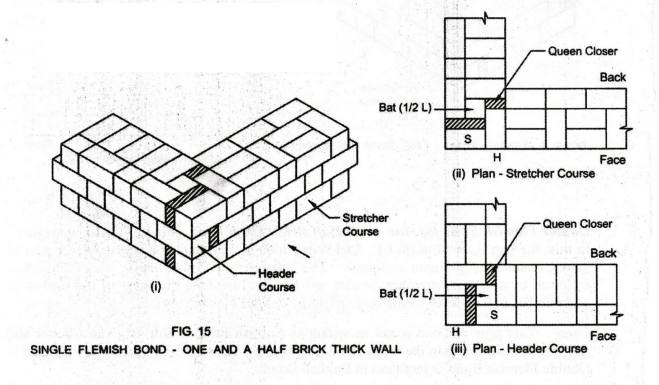
In this, Flemish Bond is adopted on the face side of the wall and English Bond is adopted on the back side of the wall.
Salient
Features of Single Flemish Bond
•
It has the better strength of English Bond and the better appearance of Flemish
Bond.
•
It requires a minimum wall thickness of one and a half brick.
•
As in the English Bond, the brick joints are straight in Single Flemish Bond.
•
Since the thickness of wall is an odd number of half-bricks, half brick bats
are used.
Comparison
of English Bond and Flemish Bond
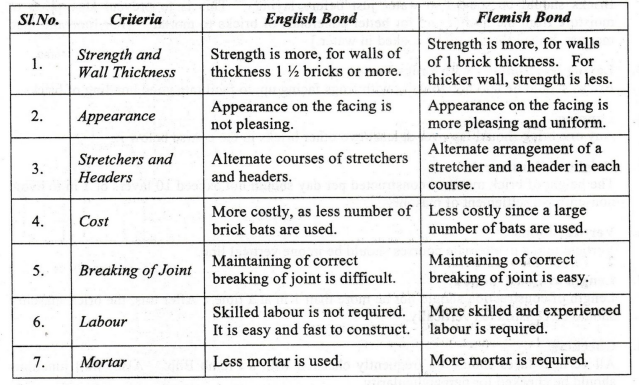
5.
RAKING BONDS
Raking
course in Raking Bond is provided between two stretcher courses. The bricks are
laid at an inclination to the direction of the wall. Raking Bonds are used for
thick walls. These are of the following two types:
1.
Zig-zag Bond: [Fig. 16] In this bond, the bricks are
laid zig-zag for paving or making ornamental finish in the brick floor.
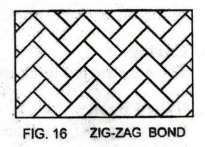
2.
Diagonal Bond: [Fig. 17] In this bond, bricks are laid
diagonally. Internal placing of bricks is made in one direction only at certain
angle of inclination, after face bricks are laid. Bricks cut to triangular
shapes are packed in the small triangular spaces at the ends.

4. PRINCIPLES OF BRICK MASONRY CONSTRUCTION
[Precautions
to be observed in Brick Masonry]
1.
IS : 1077 Quality
Bricks
should be well burnt, strong, durable, with sharp edges and standard dimensions
of uniform colour. They should satisfy IS : 1077 requirements.
2.
Soaking in Water
Bricks
should be soaked in water just before laying. This is to prevent absorption of:
moisture from the mortar and for better adherence of bricks to mortar. [For
lime and mud mortars, bricks should not be soaked in water.]
3.
Laying Horizontally with Frogs Facing up
Bricks
should be laid horizontally with frogs facing up, to facilitate good bonding of
bricks.
4.
Lapping
Any
one brick should lap over at least two other bricks in the course below it.
5.
Height of Construction
The
height of brick masonry constructed per day should not exceed 10 layers or 1 m
to avoid non-uniform settlement of masonry.
6.
Vertical Joints
Vertical
joints in alternate courses should be in one vertical line.
7.
Length of Construction
Length
of construction should not be more than 1 m at a time. After this, the brick
masonry should be constructed vertically.
8.
Checking
All
vertical faces should be frequently checked with a Plumb Bob. should be checked
for perpendicularity. Also, wall junctions
9.
Brick Bats
In
the brick work, brick bats should not be used except as Closers.
10.
Curing
The
constructed brick masonry walls should be cured for one to two weeks.
11.
Raked Back
Refer
Fig. 9(i). The incomplete end of the brickwork is raked back, by stepping the brickwork.
12.
Occurrence of Cracks
Horizontal
and vertical expansion joints should be provided in the walls to reduce the
occurrence of cracks in the walls.
Basic Civil & Mechanical Engineering: UNIT III: e. Masonry : Tag: : Terminology, Bonds in Brickwork and its Types, Principles - Brick Masonry
Related Topics
Related Subjects
Basic Civil and Mechanical Engineering
BE3255 2nd Semester 2021 Regulation | 2nd Semester EEE Dept 2021 Regulation
